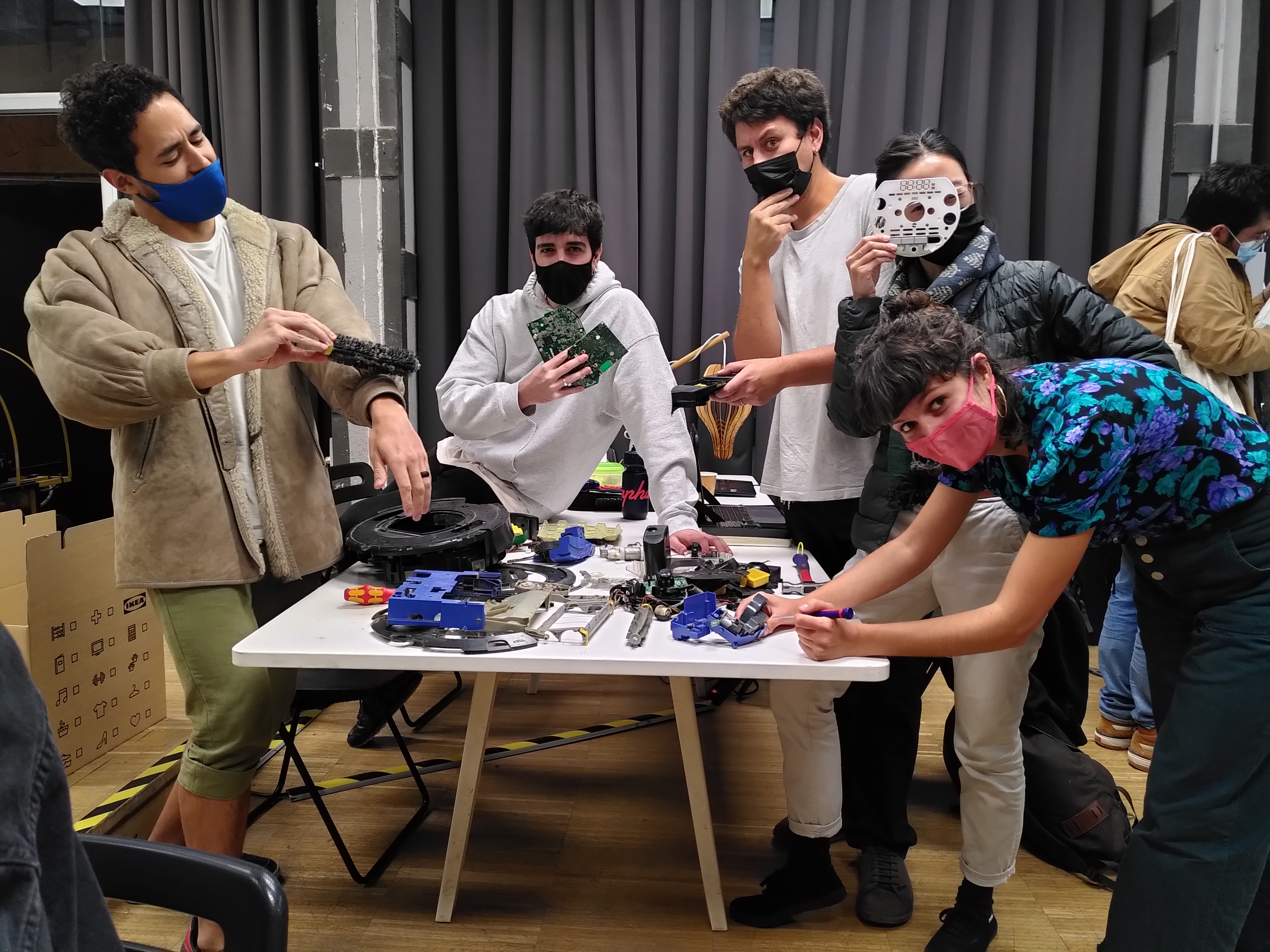tech beyond the myth
9th to 19th of November 2021
faculty: Santi Fuentemilla, Eduardo Chamorro, Guillem Camprodon, Óscar González, Victor Barberán, Dafni Gerodimou
week reflections
The objective of this tech track was to "unfold the myth behind big tech", explore different tools and techniques for prototyping, become more familiar with maker / hacker mindset and ecosystem. These two weeks were divided into 3 workshops : "Forensic of the obsolescence", "Measuring the world" and "The Almost Useful Machine".forensic of the obsolescence
For this first workshop, we were divided into groups and each group dissassembled an old electronic object (tv, mac computer, induction plate...).
In our group we opened a Rumba iRobot vacuum cleaner, the detais of our analysis and the steps we took to do it are here.
This class led to different questions to be explored further:
- What rights do we have as users?
- How to make object repairable? What new business models need to be invented to make this possible? On that topic, I have in mind the example of Fairphone that I consider very inspiring.
- How to design to open?
- Can we counter obsolescence? What makes us decide that a phone, a computer are obsolete when they are still perfectly functionning but cannot be used because of the softwares or operating systems? Could we design new software to continue using them?

More generally, it was very frustrating to see that a lot of the objects we opened had parts that were still functionning but were going to be discarted. In addition to that, none of the objects were made to be open, most of the time we would be unable to reassemble them.
measuring the world
This second workshop started with the presentation of the Smart Citizen project in Fab Lab Barcelona a few years ago. It was intersting to understand the multiscalar approach that was taken for the project involving the neighborhood community and community "champions" as kind of ambassadors. The whole project was based on an open-source approach with an open ecosystem of tools both for software and hardware.
To put this in practice, we formed new teams and followed a process from identifying an objective to an hypothesis and to data that we can collect (data in an ideal world and data in the real world). Each team could choose a tool to collect data among various possibilities : Smart Citizen Kit, PI camera, web scraping, physical interventions, GPS mobile location, arduino LDR sensor.
In my team we worked with a Smart Citizen kit on the hypothesis "I can grow the ingredients of all my meals in my neighborhood". The report of this study is here. All the results of our data collection were made available on a git repository to be potentially used by others.
What I would like to explore further:
- Data visualisation inspiration
- Physical data capture
- Open ecosystems of tools
- Concept of data proxies when data is not directly accessible

The Almost Useful Machines
For this last workshop we built "usefully useless" machines. The machines had to be useless (in the sense of not solving any problem or doing it in a stupid way) but were useful to learn about prototyping methodologies, iterative design processes.
With our group, we decided to create a machine that would "embody" the concept of vulnerability. After we agreed on the shape, the behaviour of the machine when humans interact with it, we had 2 days to make it. We split in mini teams to share the work:
- Pippa worked on the 3D model of the machine including the structure (laser cut on plywood) and the dome (3D printed),
- Aparna and Paula worked on the ESP board programing with the servo motor and microphone,
- Paula worked on the pattern for the LCD screen glossy paper that we used to cover the robot,
- Andrea and I worked on designing the mechanics system to create and up and down movement with the servo motor in order to make lights (from fiber optics) go up or down through the dome.
We formed the teams based on our skills, to make balanced teams, each team had to be a mix of : physical computing, production, designing for fabrication, communication, project management.
So I joined the team under the "project management hat" because it is the one I feel the most comfortable in based on my previous experiences. During the 2 days of workshop, I don't feel like this was the most needed skill though! I have been working with Andrea on the mechanics but I wouldn't be able to create a 2D model to be laser cut alone.
So one of the things I would like to explore further is 2D/3D modelling with Fusion or another software to be able to bring more "technical" skills to a team.